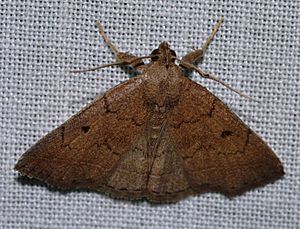Conifer zanclognatha facts for kids
Quick facts for kids Conifer zanclognatha |
|
|---|---|
 |
|
| Scientific classification | |
| Synonyms | |
|
The Zanclognatha protumnusalis, also known as the conifer zanclognatha, is a type of litter moth. It belongs to the Erebidae family of moths. This moth was first described by a scientist named Francis Walker in 1859.
You can find the conifer zanclognatha moth across a wide area. It lives from southern Canada all the way down to Florida and Texas in the United States.
Contents
What is the Conifer Zanclognatha Moth Like?
This moth is not very big. Its wingspan, which is the distance from one wingtip to the other when the wings are spread out, is about 25 millimeters (about 1 inch).
When Do These Moths Fly?
Adult conifer zanclognatha moths are usually seen flying from July to September. In the northern parts of their habitat, they typically have one generation each year. This means the moths lay eggs, and those eggs grow into new moths once a year.
In warmer places, like New Jersey, they might have a partial second generation. Even further south, they can have two or more generations (or "broods") in a single year.
The Life of a Conifer Zanclognatha Larva
The young stage of the moth is called a larva, which is like a caterpillar. These larvae are often found living on different types of conifer trees.
What Do Larvae Eat?
You might find them on trees like Atlantic white cedar, balsam fir, black spruce, jack pine, and white spruce. Scientists believe that these larvae probably eat things like lichen, algae, and detritus. Detritus is tiny bits of decaying plant and animal matter found within the trees.
How Larvae Protect Themselves
If a conifer zanclognatha larva feels like it's in danger, it has a clever way to protect itself. It will pretend to be dead! The larva rolls onto its side and curls its body up a little bit. Then, it stays completely still in that position until the danger has passed.
Images for kids


